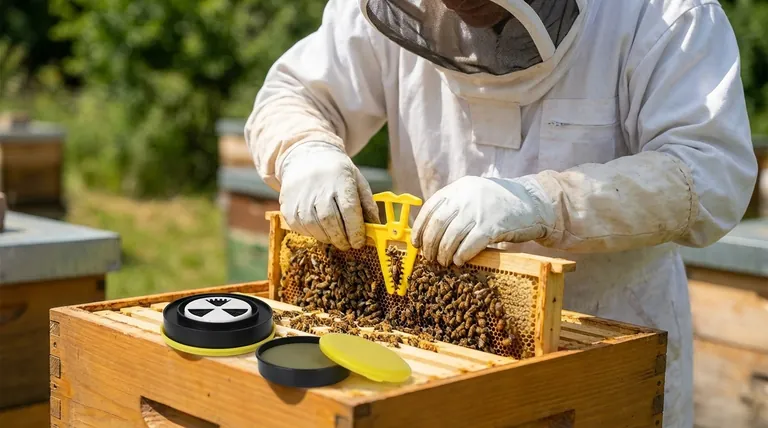To perform an alcohol wash safely, you must focus on two distinct areas: your personal protection from stings and the protection of the colony's future by ensuring the queen is not harmed. This involves wearing appropriate beekeeping gear and taking meticulous care to identify and isolate the queen before you collect your bee sample.
The core principle of a safe alcohol wash is balancing the need for accurate data against the well-being of the colony. Proper precautions ensure you can gather critical mite-level information without injuring yourself or jeopardizing the hive's survival by accidentally killing the queen.

Prioritizing Personal Safety
The process of scooping a half-cup of bees from a frame is highly disruptive and will almost certainly trigger a defensive response from the colony. Your safety depends on being prepared for this eventuality.
Essential Protective Gear
Always wear a full set of protective gear. This is not a task to be performed in street clothes, even with a seemingly calm hive.
Your minimum gear should include a beekeeping suit or jacket, a veil to protect your face and neck, and gloves. The bees in the sample, and those on the frame, will be aggravated.
Working Calmly and Deliberately
Your own demeanor is a safety tool. Move with smooth, deliberate motions. Jerky, panicked movements will only escalate the colony's defensive reaction and increase the likelihood of stings.
Protecting the Heart of the Colony: The Queen
The single most critical safety measure for the hive is to guarantee the queen is not in your sample. The loss of a queen can be a catastrophic event for a colony, and sacrificing her for a mite count negates the purpose of the test.
Why the Queen Must Be Protected
The queen is the only member of the colony capable of laying fertilized eggs, ensuring the hive's continuity and growth. Accidentally killing her during a mite test is a management failure that can set the colony back for weeks or lead to its complete demise.
The Search and Secure Protocol
Before shaking any bees, you must locate the queen. Carefully inspect the frames you intend to sample from, paying close attention to frames containing eggs and young larvae, as this is her primary domain.
Once you find her, you have two options. You can either place the frame she is on safely outside the hive box or use a queen clip or another isolation cage to secure her on the frame while you proceed. Never take a sample from a frame without being 100% certain of the queen's location.
Understanding the Trade-offs
An alcohol wash is an effective diagnostic tool, but it is not without its costs. Understanding these trade-offs is key to using the test responsibly.
The Sacrifice of the Sample
The primary trade-off is the intentional sacrifice of approximately 300 bees (a ½ cup sample). While this loss is negligible to a healthy colony of 30,000-60,000 bees, it is a necessary sacrifice made to protect the health of the entire hive from a devastating Varroa mite infestation.
The Risk of Queen Loss
Even with careful searching, there is always a small, residual risk that the queen is missed and collected. This is the most significant risk of the procedure. The precaution of finding her first is your primary method of mitigating this risk, but it is never entirely zero.
Making the Right Choice for Your Goal
Your approach should be guided by your primary objective for the test, balancing thoroughness with efficiency.
- If your primary focus is maximum colony safety: Take the extra time to positively identify the queen on a frame and set that frame completely aside before proceeding. Do not rush this step.
- If your primary focus is efficiency in a large-scale operation: Develop a consistent method, such as always sampling from the second or third frame in the brood box after a quick but thorough scan for the queen.
Following these safety protocols ensures the alcohol wash remains a powerful and responsible tool in your hive management strategy.
Summary Table:
| Safety Focus | Key Precaution | Why It's Critical |
|---|---|---|
| Personal Safety | Wear full protective gear (suit, veil, gloves) and work calmly. | Prevents defensive bee stings during the disruptive sampling process. |
| Queen Safety | Locate and isolate the queen before collecting the bee sample. | Avoids catastrophic colony loss; the queen is essential for hive survival. |
| Hive Health | Understand the trade-off of sacrificing ~300 bees for accurate data. | Necessary to monitor and control devastating Varroa mite infestations. |
Protect your apiary's health and productivity with the right equipment. Performing critical hive diagnostics like the alcohol wash test requires reliable, high-quality gear. HONESTBEE supplies durable beekeeping suits, veils, gloves, and essential tools like queen clips to commercial apiaries and distributors. Our wholesale-focused operations ensure you get the professional-grade supplies you need to manage your hives safely and effectively.
Contact HONESTBEE today to discuss your beekeeping supply needs and secure your apiary's future.
Visual Guide

Related Products
- Adjustable Formic and Acetic Acid Dispenser for Bee Mite Treatment
- HONESTBEE Advanced Ergonomic Stainless Steel Hive Tool for Beekeeping
- Professional 3-Bar Frame Grip with Integrated Hive Tool
- Plastic Chinese Queen Grafting Tool for Bee Queen Rearing
- No Grafting Queen Rearing Kit: System for Royal Jelly Production and Queen Rearing
People Also Ask
- How can beekeepers ensure their hives survive the winter? A Guide to Colony Survival
- What are phoretic mites? A Beekeeper's Guide to Monitoring Varroa Infestation
- How do Varroa mites spread between honey bee colonies? Stop Mite Transmission in Your Apiary
- What are the symptoms of Varroa Mite Syndrome (VMS)? Recognizing the Signs of Colony Collapse
- What is the focus of hive management during summer? Maximize Your Honey Harvest with Expert Tips



















